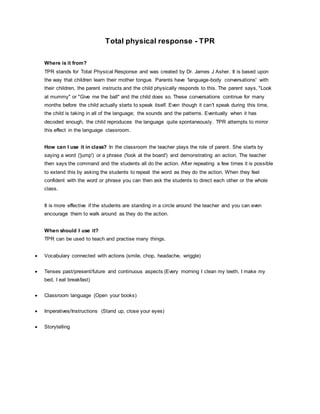
La respuesta fisica total
- 1. Total physical response - TPR Where is it from? TPR stands for Total Physical Response and was created by Dr. James J Asher. It is based upon the way that children learn their mother tongue. Parents have 'language-body conversations' with their children, the parent instructs and the child physically responds to this. The parent says, "Look at mummy" or "Give me the ball" and the child does so. These conversations continue for many months before the child actually starts to speak itself. Even though it can't speak during this time, the child is taking in all of the language; the sounds and the patterns. Eventually when it has decoded enough, the child reproduces the language quite spontaneously. TPR attempts to mirror this effect in the language classroom. How can I use it in class? In the classroom the teacher plays the role of parent. She starts by saying a word ('jump') or a phrase ('look at the board') and demonstrating an action. The teacher then says the command and the students all do the action. After repeating a few times it is possible to extend this by asking the students to repeat the word as they do the action. When they feel confident with the word or phrase you can then ask the students to direct each other or the whole class. It is more effective if the students are standing in a circle around the teacher and you can even encourage them to walk around as they do the action. When should I use it? TPR can be used to teach and practise many things. Vocabulary connected with actions (smile, chop, headache, wriggle) Tenses past/present/future and continuous aspects (Every morning I clean my teeth, I make my bed, I eat breakfast) Classroom language (Open your books) Imperatives/Instructions (Stand up, close your eyes) Storytelling
- 2. It can be adapted for all kinds of teaching situations, you just need to use your imagination! Why should I use it in the classroom? It is a lot of fun, students enjoy it and it can be a real stirrer in the class. It lifts the pace and the mood. It is very memorable. It really helps students to remember phrases or words. It is good for kinaesthetic learners who need to be active in the class. It can be used in large or small classes. It doesn't really matter how many students you have as long as you are prepared to take the lead, the students will follow. It works well with mixed-ability classes. The physical actions get across the meaning effectively so that all the students are able to understand and use the target language. It doesn't require a lot of preparation or materials. As long as you are clear what you want to practise (a rehearsal beforehand can help), it won't take a lot of time to get ready. It is very effective with teenagers and young learners. It involves both left- and right-brained learning. A few useful variations When I use TPR, first I get the students to do the actions and then I do them and drill the students (chorally and individually) to give them an opportunity to practise making the sounds. They are then ready to give commands to each other. A game I like to play is to organize the students into a circle around me, I say the word and the last person to do the action is out. This person then stands behind me and watches for the student who does the action last. Eventually there is only one student, she is the winner. You can extend this by playing Simon Says. This time when you give a command, students should only do it if you say "Simon says..." at the start. I might say, "Simon says, 'slice some bread'" or "Simon says, 'chop an onion'" and the students must do the action. However if I say, "Whisk an egg" the students shouldn't do this. If anyone does the action that Simon doesn't say then they are out and have to watch for the mistakes of the other students.
- 3. Are there any disadvantages with using TPR? Students who are not used to such things might find it embarrassing. This can be the case initially but I have found that if the teacher is prepared to perform the actions, the students feel happier about copying. Also the students are in groups and don't have to perform for the whole class. This pleasure is reserved for the teacher. It is only really suitable for beginner levels. Whilst it is clear that it is far more useful at lower levels because the target language lends itself to such activities I have also used it successfully with Intermediate and Advanced levels. You need to adapt the language accordingly. For example, it helped me to teach 'ways of walking' (stumble, stagger, tiptoe) to an advanced class and cooking verbs to intermediate students (whisk, stir, grate). You can't teach everything with it and if used a lot it would become repetitive. I completely agree with this but it can be a successful and fun way of changing the dynamics and pace of a lesson used in conjunction with other methods and techniques.
